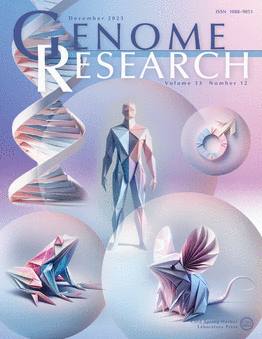Integration of hyperspectral imaging and transcriptomics from individual cells with SpectralSeq
IF 5.5
2区 生物学
Q1 BIOCHEMISTRY & MOLECULAR BIOLOGY
引用次数: 0
Abstract
Microscopy and omics are complementary approaches to probe cellular molecular states in health and disease, combining granularity with scalability. However, integrating both imaging- and sequencing-based assays on the same cell has proven challenging. This study demonstrates a new approach called SpectralSeq that combines hyperspectral autofluorescence imaging with transcriptomics on the same cell. SpectralSeq is applied to Michigan Cancer Foundation-7 (MCF-7) breast cancer cells and identifies a subpopulation of cells exhibiting bright autofluorescence rings at the plasma membrane in optical channel 13 (λex = 431 nm, λem = 594 nm). Correlating the presence of a ring with the gene expression in the same cell indicates that ringed cells show higher expression of apoptosis-related genes and lower expression of ATP production genes. Furthermore, correlation of cell morphology with gene expression reveals downregulation of multiple spliceosome members in larger MCF-7 cells. Multiple genes exhibit consistent expression across cell sizes but varied exon usage. Finally, correlation between gene expression and fluorescence within the spectral range of nicotinamide adenine dinucleotide hydrogen (NADH) provides insights into the metabolic states of MCF-7 cells. Overall, SpectralSeq links optical spectrum with internal molecular states, offering a single streamlined workflow for single-cell resolution studies integrating spectral, morphological, and transcriptomic analyses.利用SpectralSeq整合来自单个细胞的高光谱成像和转录组学
显微镜学和组学是探索健康和疾病中细胞分子状态的互补方法,将粒度与可扩展性相结合。然而,在同一细胞上整合基于成像和基于测序的检测被证明是具有挑战性的。这项研究展示了一种名为SpectralSeq的新方法,该方法将高光谱自身荧光成像与转录组学结合在同一细胞上。SpectralSeq应用于密歇根癌症基金会-7 (MCF-7)乳腺癌细胞,并在13光通道(λex = 431 nm, λem = 594 nm)的质膜上识别出一个显示明亮自身荧光环的细胞亚群。将环的存在与同一细胞中基因的表达联系起来,表明环细胞中凋亡相关基因的表达较高,而ATP产生基因的表达较低。此外,细胞形态与基因表达的相关性显示,在较大的MCF-7细胞中,多个剪接体成员下调。多个基因表现出一致的表达跨越细胞大小,但不同的外显子使用。最后,在烟酰胺腺嘌呤二核苷酸氢(nicotinamide adenine dinucleotide hydrogen, NADH)的光谱范围内,基因表达与荧光之间的相关性为MCF-7细胞的代谢状态提供了见解。总的来说,SpectralSeq将光谱与内部分子状态联系起来,为单细胞分辨率研究提供了一个单一的流线型工作流程,集成了光谱、形态和转录组分析。
本文章由计算机程序翻译,如有差异,请以英文原文为准。
求助全文
约1分钟内获得全文
求助全文
来源期刊

Genome research
生物-生化与分子生物学
CiteScore
12.40
自引率
1.40%
发文量
140
审稿时长
6 months
期刊介绍:
Launched in 1995, Genome Research is an international, continuously published, peer-reviewed journal that focuses on research that provides novel insights into the genome biology of all organisms, including advances in genomic medicine.
Among the topics considered by the journal are genome structure and function, comparative genomics, molecular evolution, genome-scale quantitative and population genetics, proteomics, epigenomics, and systems biology. The journal also features exciting gene discoveries and reports of cutting-edge computational biology and high-throughput methodologies.
New data in these areas are published as research papers, or methods and resource reports that provide novel information on technologies or tools that will be of interest to a broad readership. Complete data sets are presented electronically on the journal''s web site where appropriate. The journal also provides Reviews, Perspectives, and Insight/Outlook articles, which present commentary on the latest advances published both here and elsewhere, placing such progress in its broader biological context.
 求助内容:
求助内容: 应助结果提醒方式:
应助结果提醒方式:


